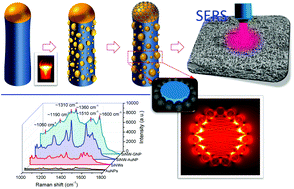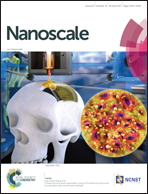A new heterostructured SERS substrate: free-standing silicon nanowires decorated with graphene-encapsulated gold nanoparticles†
Abstract
Heterostructures of one-dimensional nanowire supported graphene/plasmonic nanoparticles are promising for future SERS-based chemical sensors. In this paper, we report a novel heterostructured SERS substrate composed of free-standing Si nanowires and surface-decorating Au/graphene nanoparticles. We successfully developed a unique CVD approach for the cost-effective and large-scale growth of free-standing Si nanowires. Au nanoparticles were decorated on the Si nanowires using a galvanic deposition – an annealing approach. This was followed by the selective growth of a multilayer graphene shell on the Au nanoparticles via a xylene-based CVD approach. Discrete dipole approximation simulation was used to understand the plasmonic properties of these Si nanowire-based heterostructures. The results indicate that the incorporation of Au nanoparticles and graphene on Si nanowires has a significant influence on their light absorption and scattering properties. Meanwhile, a strong surface plasmon coupling was observed at the interface regions of different materials (e.g., Si/Au, Au/graphene), introducing multiple co-enhanced “hot spots” on the heterostructures. We found that our new heterostructures have a combined effect of an electromagnetic mechanism and a chemical mechanism for SERS and demonstrate an enhancement factor of 106–107.



 Please wait while we load your content...
Please wait while we load your content...